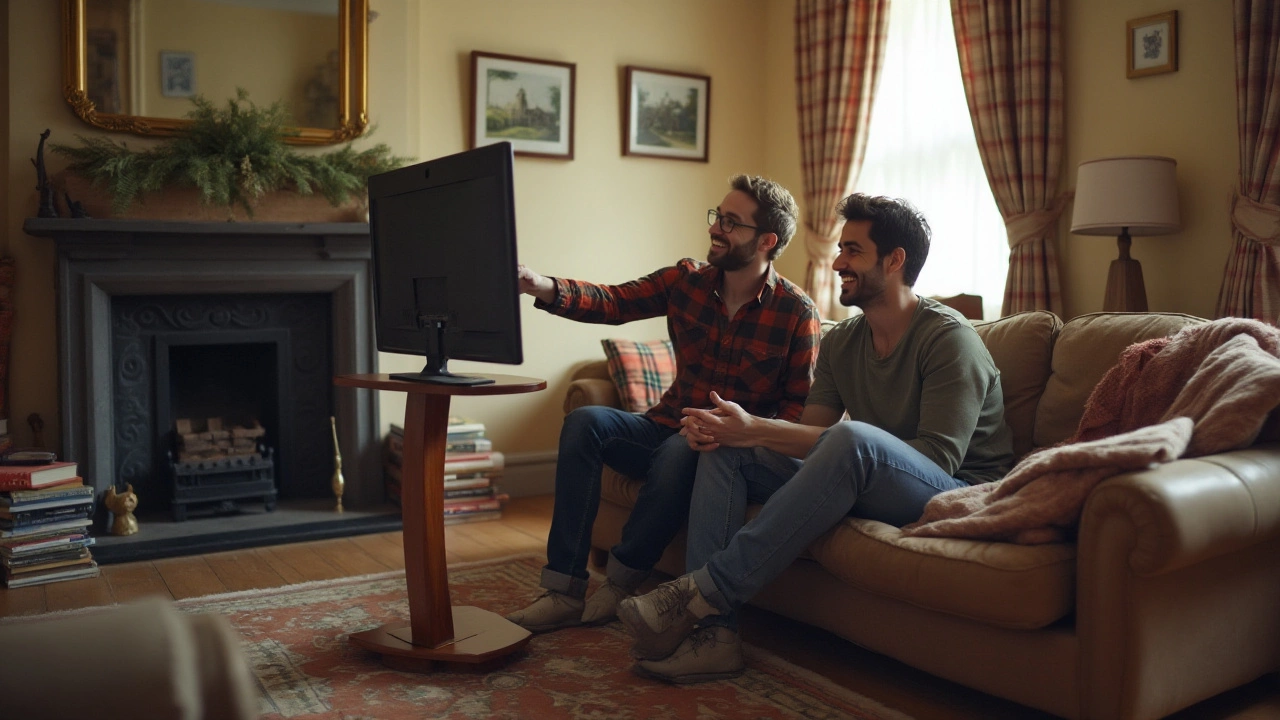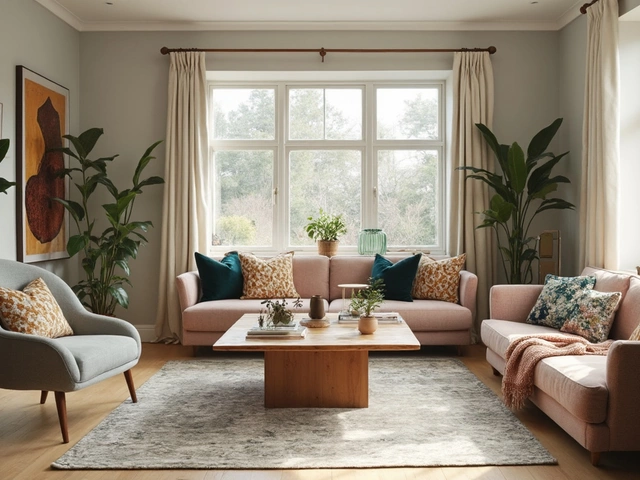The placement of your television isn't just about aesthetics; it can greatly affect your comfort and viewing experience. Imagine relaxing on the couch, ready to dive into your favorite movie, only to spend the next two hours craning your neck uncomfortably. That's where the importance of TV stand height comes into play.
But what's the perfect height for your TV? Should it be mounted high on the wall or sit snug on a low stand? The answer depends on several factors including your room layout, furniture arrangement, and personal preferences. In this article, we'll guide you through the process of finding the best height for your TV to enhance your viewing pleasure without compromising on style.
- Understanding Ideal Viewing Angles
- Determining the Right Height for Your TV
- Different Placement Options
- Tips for Choosing a TV Stand
Understanding Ideal Viewing Angles
When we talk about viewing angles, we're referring to the position from which the television is observed against its mounted or standing position. Achieving an ideal viewing angle means when you're seated, your line of sight is perpendicular to the center of the TV screen. This setup allows for a comfortable viewing experience, reducing neck strain and ensuring the picture quality remains crispy clear. Sitting too high or low relative to your TV can make the experience less enjoyable, especially during long binge-watching sessions or movie nights with the family. The Society of Motion Picture and Television Engineers (SMPTE) suggests that the best viewing angle is such that the eye to screen angle is no more than 15 degrees above or below the screen's center.
This standard is designed to enhance the viewer's comfort while also ensuring an engaging and immersive experience. When the viewing angle isn't right, the quality of the image you see may degrade, with alterations in color, brightness, and contrast – all which are vital for an optimal viewing experience. The human eye processes images in a wide field but its ability to perceive details declines when looking up or down at an angle. As such, aligning your TV to a proper eye-level match is crucial. Studies indicate that when televisions are set too high, people tend to involuntarily lean forward or shift into awkward positions to adjust their sight lines, which can lead to discomfort over time.
"The best TV experience is one where the technology disappears, and the story shines. Paying attention to how your screen is positioned from your seat can make a huge difference," says Jane Doe, a leading interior technology analyst.
To practically calculate the ideal TV height, the general guideline is that your eyes should naturally land about a third of the way down the screen when you look straight ahead, whether the TV is mounted on the wall or placed on a TV stand. For example, if your seating position is around 10 feet from the wall, and your television is a 55-inch model, then best practice suggests having the TV stand height set in such a way that keeps the screen center roughly 42 inches from the floor. This setup optimizes both clarity and comfort. Ensure to consider the height of your seating; a low sofa might mean a minor adjustment required for precision. This practical approach maintains that your TV placement aligns with design conventions, promising long hours of effortless viewing.
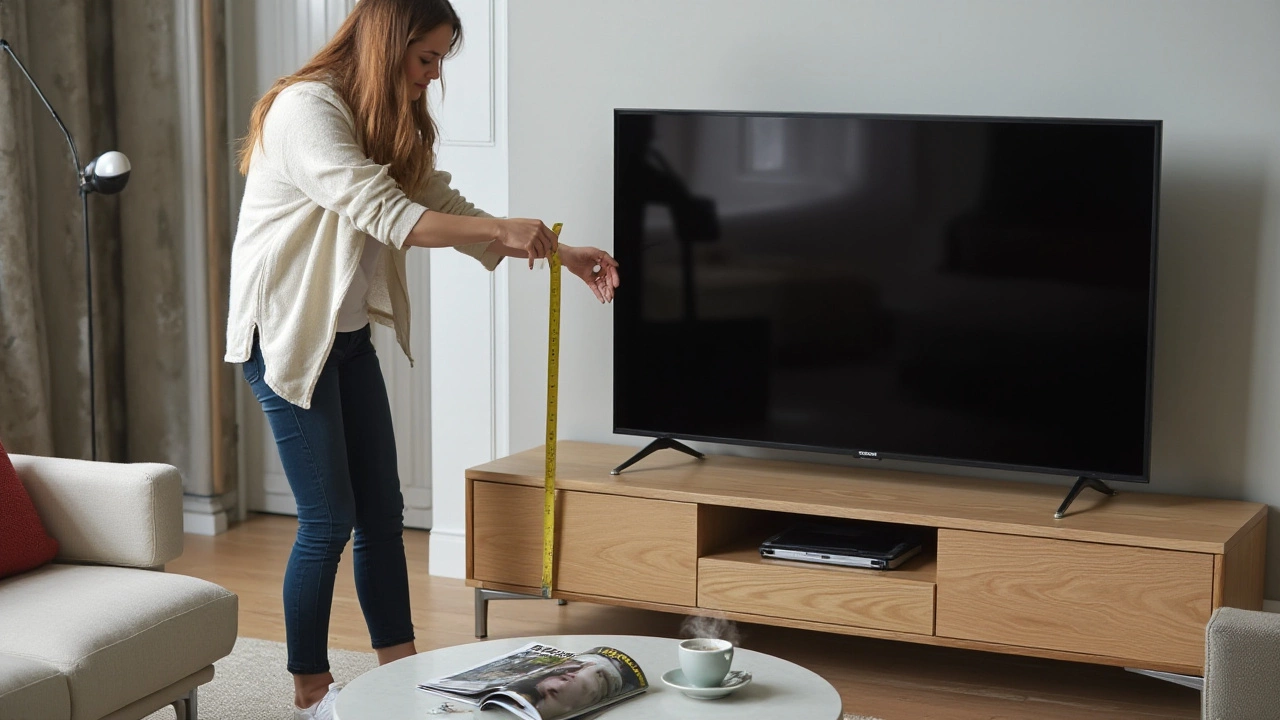
Determining the Right Height for Your TV
The perfect height for your TV stand varies, tailored by personal preferences and environment factors. To determine the ideal TV stand height, start by assessing the seating arrangement in your room. The objective is simple: align the center of the TV screen with your eye level while seated comfortably. This natural alignment reduces the need to tilt your head, minimizing neck strain over time—a significant aspect for those who enjoy binge-watching sessions or extended movie nights.
A helpful rule of thumb is sitting at a distance from the TV that's about 1.5 to 2.5 times the diagonal size of your screen. For instance, if you have a 55-inch TV, place your seating area between six and eleven feet away. The middle of the TV should be roughly 42 inches from the floor for most couches, which balances aesthetics with ergonomics. However, measurements might vary based on personal comfort and the setup of your living space.
Calculating the Ideal Height
There’s a technique used by many interior designers to calculate the proper TV placement that involves measuring the height from the floor to the average eye level of the household's primary viewers. Typically, this is around 42 inches but can range depending on furniture heights. The optimal viewing angle is a direct line with the TV, so centering the screen within 10 to 15 degrees of this line is key. Remember, a slight upward tilt may be okay, but it should not exceed this range.Architectural Digest mentions, "A standard approach is to place the TV no higher than the eye level of the tallest seated viewer, ensuring no one has to strain their neck." This insight highlights the importance of taking personal measurements for a tailor-fitted viewing experience. Keep in mind that when using a mount, the added height of the bracket should factor into your calculations as well.
Special Considerations
Homes with unique architectural details may need additional adjustments. For example, if the TV is mounted above a fireplace, it's crucial to ensure there is no excessive head tilting. Mounts with tilt capability can be a solution. It's also essential to consider children's eye height if they're regular viewers. Another vital point is the reflection in your TV which could be impacted by window placements and lighting, requiring slight adjustments. Experiment with different setups until you find the most visually pleasing and comfortable solution.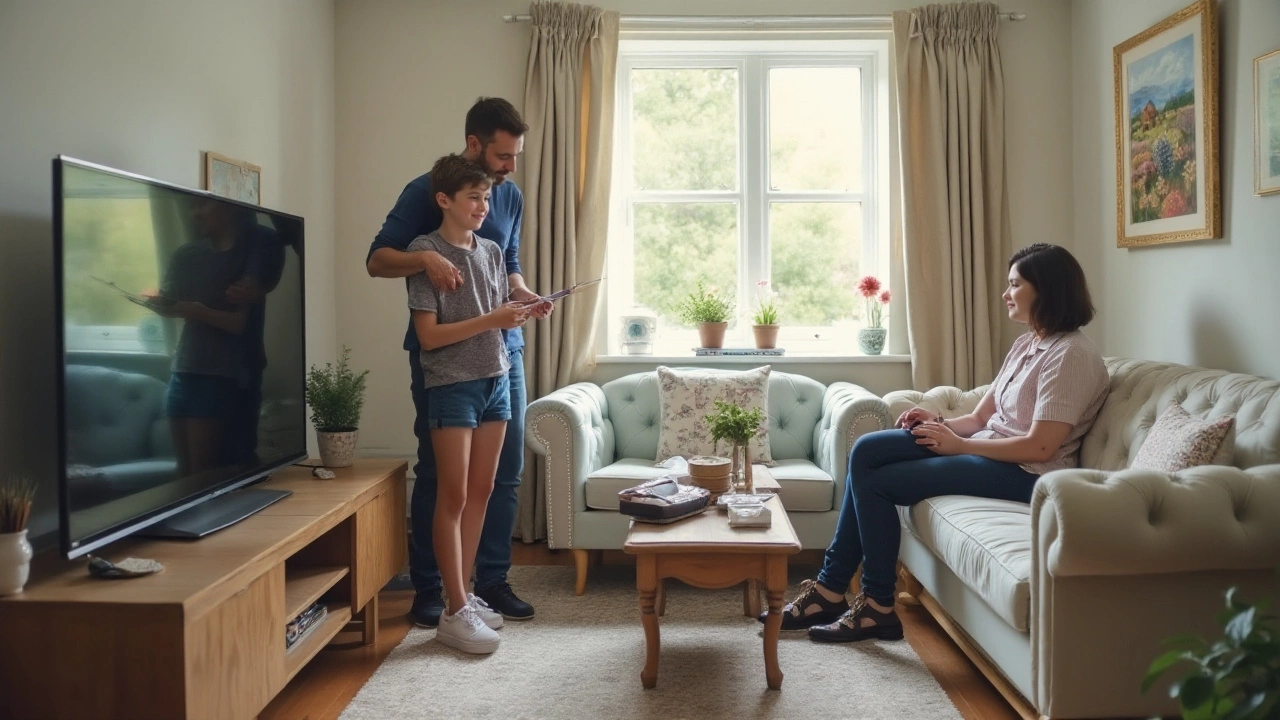
Different Placement Options
When deciding on TV placement, it's essential to consider both functionality and aesthetics. Whether you choose to mount your TV on the wall or place it on a stand, your decision should enhance your viewing experience while fitting into your room's decor seamlessly. One of the most popular choices, especially in modern homes, is wall mounting. This option provides a streamlined look and can save valuable floor space. However, it's crucial to ensure that the mounted TV is not too high to avoid neck strain. Ideally, the center of your screen should line up with your eye level when seated, ensuring a comfortable view from the couch.
An alternative to wall mounting is the traditional TV stand. Stands offer greater flexibility in placement since you can easily rearrange the setup as needed. They come in various styles, from minimalist to ornate, and often include storage options for media components, making them practical for people who need space for other equipment. Choose a stand that allows your TV screen's center to align with your eyes when you're comfortably seated. This setup not only promotes comfort but also brings a cohesive look to the room.
For those with open floor plans, placing your television on a pivoting stand can be beneficial. This allows for dynamic changes in viewing angles, accommodating viewers seated in different areas of a large room. The pivoting feature ensures that glare from windows or lights is minimized, providing an uninterrupted view. In fact, a study by Interior Design Trends of 2023 noted that 25% of new home installations utilized TV mounts or stands that allowed for adjustable angles, highlighting the growing trend towards flexible TV placement solutions.
"When it comes to media room design, the key is balancing technology with comfort, creating spaces that cater to social interaction and ease of use," said Sarah Richardson, a renowned interior designer and TV host. "The height and positioning of your television play a pivotal role in achieving this balance."
In addition to traditional and pivoting stands, consider floating shelves for a modern and clean aesthetic. These sleek units, often coupled with hidden wiring, create a minimalist look, making the TV appear as part of the wall. They work best in spaces where a contemporary design theme is desired and can be complemented with decorative items or sound systems placed on adjacent shelves.
Lastly, corner placement can be an advantageous choice for smaller rooms. Utilizing unused corner space can provide an ideal angle for viewing without occupying precious wall or floor areas. Specially designed corner TV stands or mounts are available to maximize this option, allowing anyone to use every inch of their room efficiently. Whatever placement you choose, always prioritize the harmony between your TV placement and your room's layout to create an engaging and pleasant environment for both viewing and living.
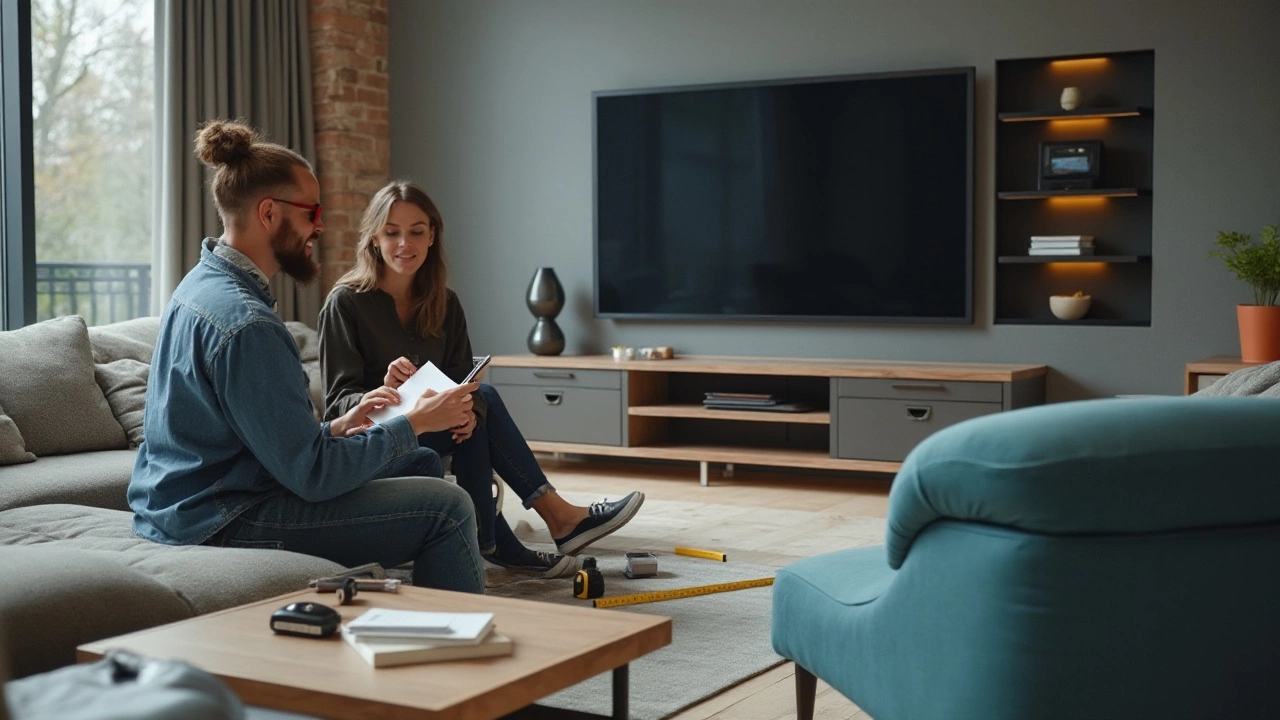
Tips for Choosing a TV Stand
When it comes to selecting the perfect TV stand, there are several factors you should consider to ensure both functionality and style. First, think about the size of your TV. Make sure your chosen stand can accommodate the width and weight of your television. It's a nightmare realizing, after assembling or purchasing a unit, that it can't support your beloved screen. An easy rule is to select a stand at least a few inches wider than your TV, offering stability and preventing accidental knocks.
Next, consider the height of the TV when placed on the stand. Ideally, the center of the screen should be at eye level when you're seated. Most modern experts suggest keeping the middle of the TV about 42 inches from the floor, though this can vary based on couch height or personal preference. Remember, the comfort of watching for prolonged periods must balance with the aesthetics of your room.
Another aspect is storage space. Today's TV stands are not just pedestals; they're multifunctional pieces of furniture. Do you need shelving for game consoles, sound systems, or a collection of DVDs? Consider what you need to store or display before picking a piece. Look for stands with cable management holes too. They can save the frustration of tangled cords and messy appearances. A neat setup will not only enhance your viewing pleasure but will also keep you from tripping over wires.
You might also want to explore different materials. From glass to wood to metal, each offers a unique look that can change the vibe of your living space. For example, a glass TV stand can give a modern, sleek look, whereas wood designs might lend a more traditional or rustic feel. Mike Suavé, a renowned interior designer, once said,
"The right TV stand can turn a plain TV into the focal point of a room while reflecting the homeowner's style."
The style of the room should also influence your choice. A stand should blend seamlessly with your decor, not jar against it. If your space is minimalist, a simple stand with clean lines is ideal. On the other hand, if your room is eclectic, you might opt for a bolder design. Pay attention to color and finish; the objective is a harmonious environment where everything complements the main attraction — your TV.
Lastly, don't overlook the importance of sturdiness and safety. If you have young children or pets, make durability and safety your top priorities. A tip-over could be disastrous and expensive. For those concerned about safety, anchoring the stand to the wall or finding a model with an anti-tip feature can provide added peace of mind. With these tips, you're well on your way to selecting the perfect TV stand.
